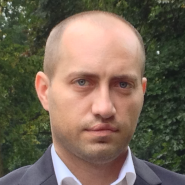Committer Profile: Lukas Jungmann
At a Glance: Lukas Jungmann

- Involved in open source since: 2004
- Works for: Oracle Corporation
- Eclipse Foundation contributor since: 2010
- Involved in: 14 Jakarta EE projects
- Committer to: 12 Jakarta EE projects
- Committer since: 2013
- Fun fact: You can add the month numbers his first two children were born in — three and five for March and May — to get the month number his third child was born in — eight for August. Three, five, and eight also represent the last number of the year in which each child was born.
Why did you first get involved in open source software and communities?
In 2004, in my first job as a quality engineer at Sun Microsystems, I was working on the NetBeans IDE, which was an open source project with a community around it. Sometimes, I was supporting users until the early morning hours. I received a big thank you email and that was really rewarding. It made me realize how much I enjoy helping people so I increased my activities.
How did that involvement lead to you becoming an Eclipse committer?
I became involved with the Eclipse Foundation in 2010 when I was working for Red Hat. Then, in 2013, I was working as a developer at Oracle and there was an opportunity to move to the EclipseLink project, and that’s when I gained committer status.
In EclipseLink, if you want to be a committer, you need to provide at least 10 valuable contributions. It could be a bug fix, a documentation update, a wiki page. Everything counts, but we want to see that people are actively trying to help the project.
When Oracle decided to donate everything related to Java EE to the Eclipse Foundation, I became even more involved. Because I had the benefit of knowing how things work within the Eclipse Foundation, I was able to share my knowledge and help my colleagues move projects over to the Eclipse Foundation faster.
How would you summarize your experiences as a committer?
The best thing about being a committer is to see that you’re able to help people move their projects forward. There’s real personal satisfaction.
It’s challenging to understand the processes around the project life cycle and the legal implications, but the Eclipse Foundation provides a Committer’s Handbook that contains everything a committer needs to know. It’s an invaluable source of information.
Also, the people involved in the Eclipse Foundation are really helpful and kind. If something is not clear or you need help, you can just file a bug through Bugzilla and ask for help and the problem will be solved pretty quickly.
What are your next steps and goals as a committer and Eclipse Foundation community member?
Right now, I’m not looking very far ahead because I’m completely focused on helping to make Jakarta EE 9 a successful release.
What would you say to developers who are considering getting more involved in open source software projects at the Eclipse Foundation?
It’s a very good way to solve problems you’re having because Eclipse open source is all about contributions and collaboration. If you have a project that’s not getting appropriate attention, the Eclipse community can help you move it forward.
When you get involved, start by doing small stuff. It may seem as though it’s not important, but it very often is, and it’s the best way to understand the project and how it works. You can grow your knowledge about a project and the processes around it to gain experience and work toward committer status if that’s what you want.
